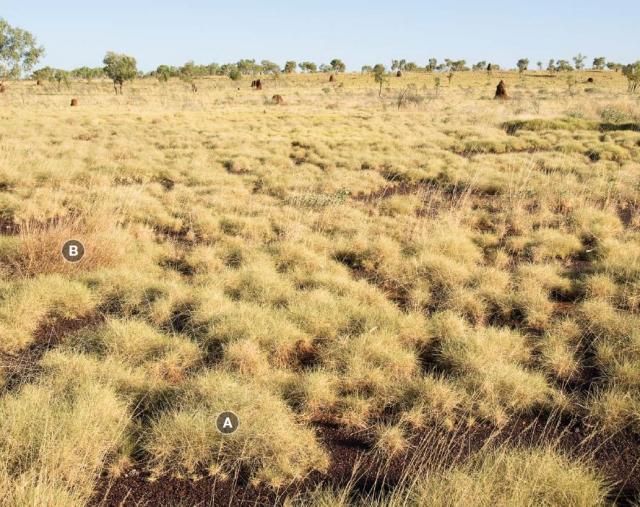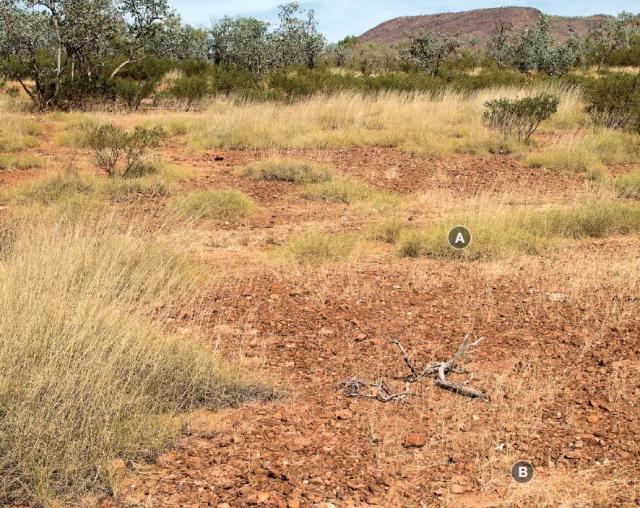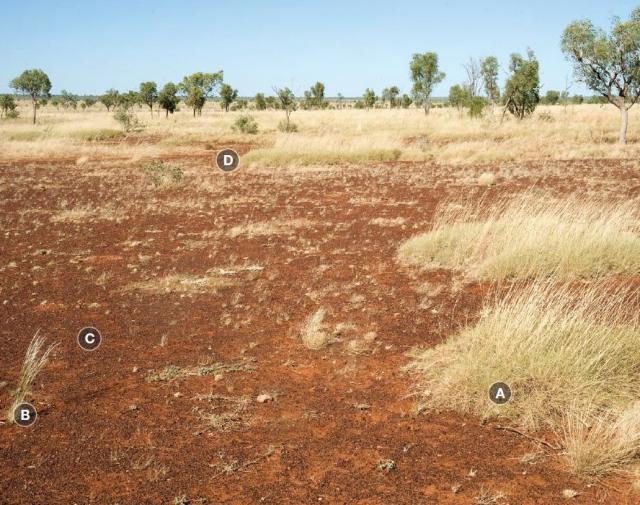Hard spinifex plain pastures
These pastures are part of the Kimberley red soil group - spinifex pastures, and hard spinifexes are the identifier grasses. Use the interactive key to pasture condition to help identify pasture type.
Pastoral value
Hard spinifex plain pastures have a very low pastoral value. Hard spinifex is unpalatable at most stages of growth, although cattle may sometimes graze spinifex plants regenerating after fire. Frequent burning of small areas off tracks can lead to a concentration of livestock on the regenerating pasture and a decline in condition.
Grazing pressure needs to be managed to prevent the few palatable species present being grazed out. Despite its low palatability, hard spinifex is considered a desirable species in this pasture type because it is a perennial and helps control erosion.
Occurrence
Hard spinifex plain pastures occur on level to undulating plains in drier areas of the Kimberley. They are found on loamy and sandy soils which are generally shallow or stony. They occur as hummock grasslands, with occasional trees or shrubs.
Pasture condition
Good: In good pasture condition, there is an even coverage of hard spinifex plants. A few desirable perennial grasses, such as silky browntop, ribbon grass and soft spinifex, may occur in low numbers between spinifex hummocks but they will tend to be concentrated along the drainage lines or under trees (Figure 1).
A variable cover of palatable intermediate annual grasses, such as limestone grass, may also be found for a short time following a good wet season.

Fair: Hard spinifex is generally ignored by livestock, so it is mainly the species growing between spinifex plants that cattle will graze when on these pastures. For this reason, a decline from good to fair condition is usually accompanied by reduced frequency and vigour of the palatable species.
The coverage of spinifex plants may appear patchy or uneven, with the areas in-between supporting a sparse cover of annual and undesirable perennial grasses, such as threeawns. Poor post-fire grazing management leading to overgrazing can cause an uneven appearance in this pasture type (Figure 2).

Poor: In poor condition, larger bare patches occur among the spinifex. Desirable grasses lack vigour or are absent. Any non-spinifex species present tend to be undesirable perennial grasses, or annuals with low fodder value. The abundance of annual grasses depends on the season (Figure 3).

Associated plants
| Common name (link to DPIRD species page) | Scientific name | Life form |
|---|---|---|
| Desirable species | ||
| Triodia intermedia, Triodia wiseana and other hard Triodia spp. | perennial grasses | |
| perennial grass | ||
| perennial grass | ||
| perennial grass | ||
| perennial grass | ||
| Intermediate species | ||
| Citronella grass | perennial grass | |
| perennial grass | ||
| annual or short-lived perennial grass | ||
| Wire grass, Northern Wanderrie grass | perennial grass | |
| Slender Wanderrie grass | annual grass | |
| annual or short-lived perennial grass | ||
| Undesirable species | ||
| Threeawn grasses | Aristida spp. | annual or perennial grasses |

